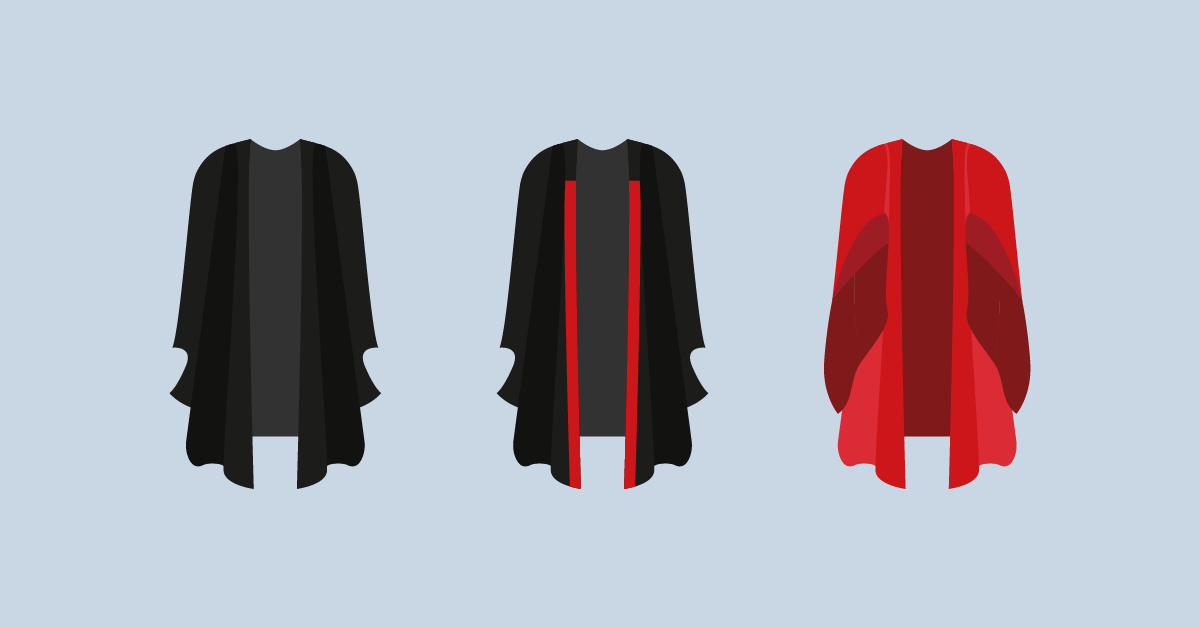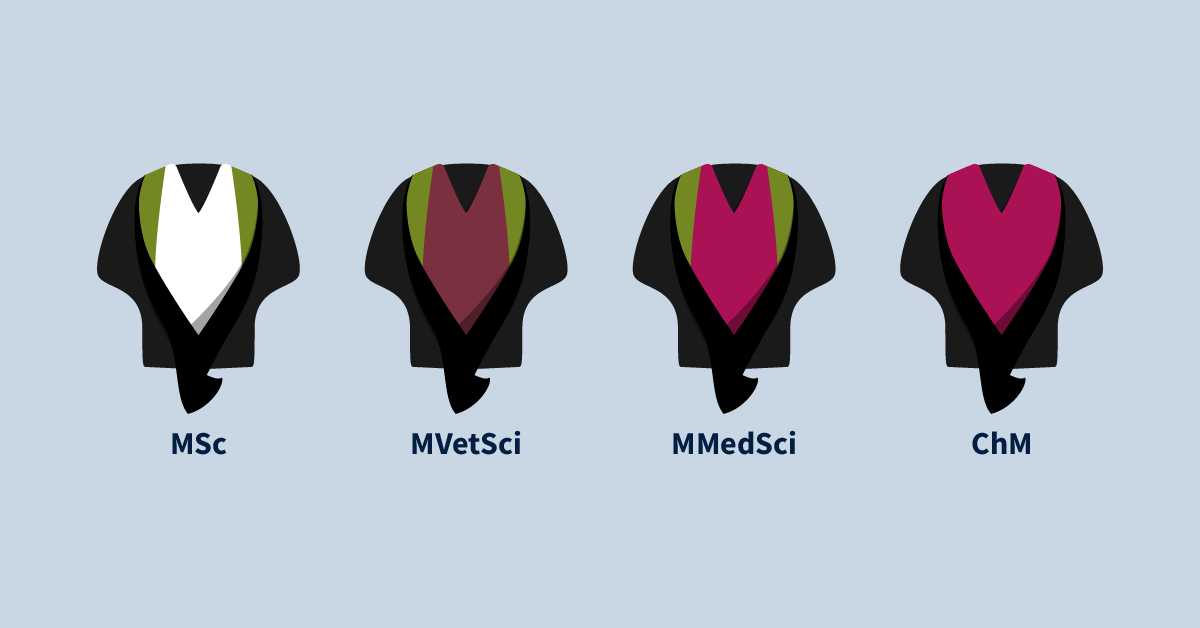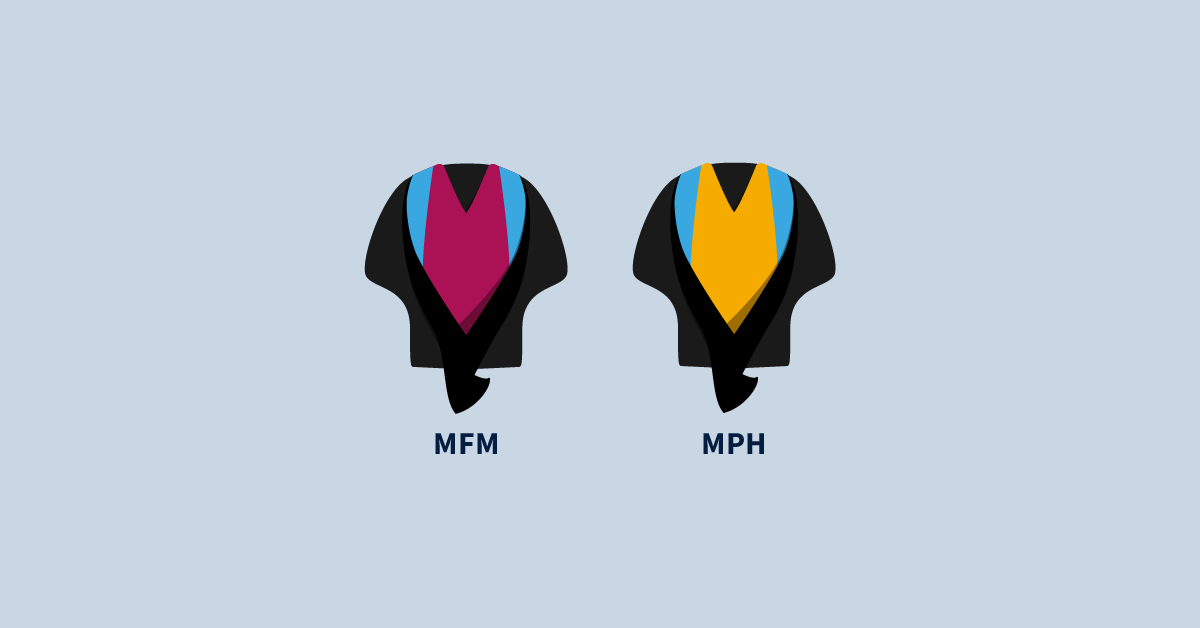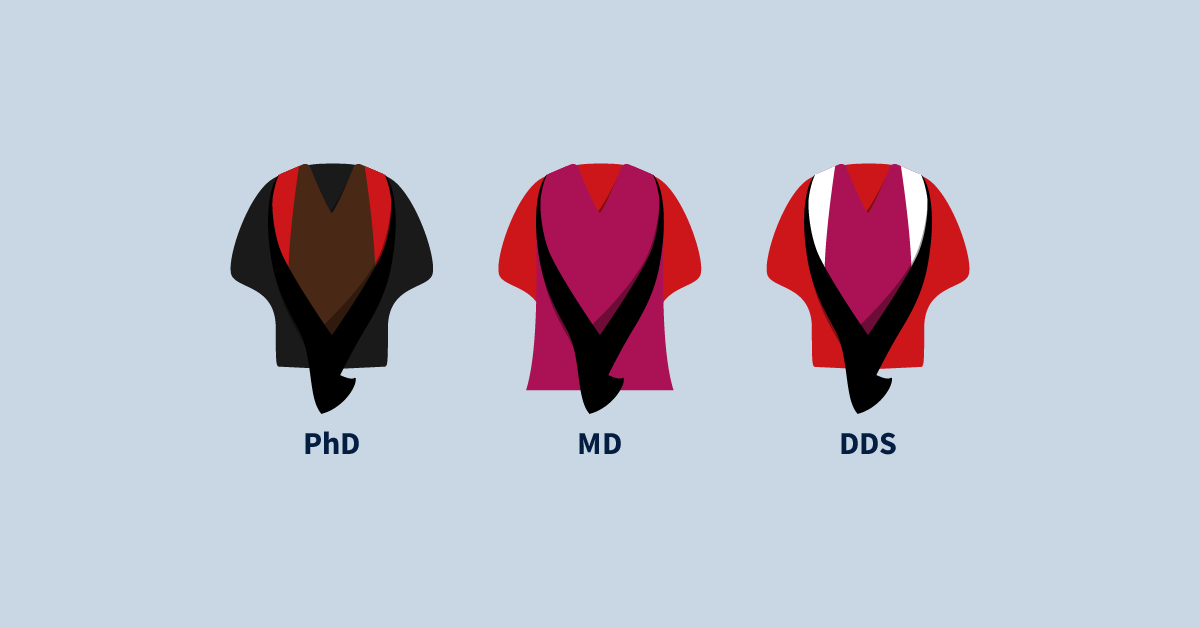What do hood and gown colours mean at graduation?

When University of Edinburgh students graduate, McEwan Hall is awash with a rainbow of bright colours. But what do these gown and hood colours signify?
Twice a year at the University of Edinburgh, we get to celebrate the successes of our students at their graduations. These ceremonies are held in the spectacular surroundings of McEwan Hall in the centre of Edinburgh.
One thing you may notice about these ceremonies is the variety of colours worn by our graduating students. These colours relate to the subject and type of degree students are about to receive.

Academic gowns and hoods
Academic dress at the University of Edinburgh is made up of a gown and a hood. Most of our graduates wear a black ‘masters’ gown.
However, there are different gowns for those receiving some of our doctorates.
Doctor of Philosophy (PhD) and Doctor of Clinical Dentistry (DClinDent) graduates wear a gown with a blue lining and red border. And those receiving a Doctor of Medicine (MD) or Doctor of Dental Surgery (DDS) degree wear a scarlet robe.

A ‘masters’ gown (left), a Doctor of Philosophy gown worn by PhD and DClinDent graduates (centre), and a scarlet Doctor robe worn by MD and DDS graduates (right).
These gowns are worn with ceremonial hoods corresponding to the specific award students will be receiving.
Postgraduate certificates and diplomas
Students graduating with a postgraduate certificate (PgCert) or a postgraduate diploma (PgDip) wear a University Blue hood lined with white and bordered with red.
This qualification is usually given to students who have completed one of our shorter online programmes – typically one or two years of part-time study.

Hood worn by students graduating with a Postgraduate Certificate (PgCert) or a Postgraduate Diploma (PgDip).
Read more: What’s the difference between a PgCert, a PgDip and a masters degree?
Masters degrees
Students who have completed a masters programme are awarded one of our masters degrees.
The name of a student’s award depends on the subject they studied. Most masters programmes in the College of Medicine and Veterinary Medicine lead to the award of Master of Science.
But there are some exceptions.
Students graduating with a Master’s in Advanced Clinical Practice or a Master’s in Conservation Medicine are awarded a Master of Veterinary Science (MVetSci) degree. This hood is lined with light maroon and bordered with the same green as the MSc hood.
And students graduating with many of our surgical masters will receive the degree of Master of Surgery (ChM). The ChM hood is lined with crimson silk without a border.
There is also a separate hood for Masters in Medical Sciences (MMedSci) graduates. This hood is lined with crimson and bordered with green.

Hoods worn by students graduating with Master of Science (MSc), Master of Veterinary Science (MVetSci), Master of Medical Science (MMedSci) and Master of Surgery (ChM) degrees.
Two other masters programmes that lead to their own unique awards are the Family Medicine and Public Health (online or on campus), which lead to the awards of Master of Family Medicine (MFM) and Master of Public Health (MPH), respectively.
MFM graduates’ hoods are lined with crimson while those of MPH graduates are lined with saffron yellow; both hoods are bordered with deep turquoise silk.

Hoods worn by students graduating with Master of Family Medicine (MFM) and Master of Public Health (MPH) degrees.
Taught programmes in dentistry
Students who complete a full time taught programmes in Endodontology, Orthodontics, Paediatric Dentistry or Prosthodontics are awarded a Doctor of Clinical Dentistry (DClinDent) award. This hood is lined with crimson and bordered with red silk. As this is a doctoral award, DClinDent graduates wear the PhD robe.
Some of these programmes also allow students to study for a shorter period and receive a Master of Clinical Dentistry (MClinDent) degree. This hood is lined with white and bordered with red silk.

Hoods worn by students graduating with Master of Clinical Dentistry (MClinDent) and Doctor of Clinical Dentistry (DClinDent) degrees.
Research programmes
As well as taught programmes, the University of Edinburgh also offers research degrees.
Those studying one of our Master of Science by Research (MScR) programmes wear the same hood as other MSc graduates.
Most students who complete a doctoral research programme receieve a Doctor of Philosophy (PhD) award. They wear a hood lined with blue silk shot with brown and bordered with three inches of red silk.
We also offer a research programme in Medicine. This is a degree undertaken by clinically qualified staff normally during their postgraduate medical training and leads to the qualification of Doctor of Medicine (MD). MD graduates wear the scarlet Doctor robe and a black hood with appended cape, lined and faced with crimson silk.
Another research degree we offer is the part-time Dental Surgery programme, which leads to the award of Doctor of Dental Surgery (DDS). As well as the scarlet Doctor robe, DDS graduates wear a black hood lined with crimson and bordered with white silk.

Hoods worn by students graduating with Doctor of Philosophy (PhD), Doctor of Medicine (MD) and Doctor of Dental Surgery (DDS) degrees.
Undergraduate programmes
Students graduating from most undergraduate programmes in the College of Medicine and Veterinary Medicine receive a bachelors degree. Hoods for these awards differ by the inclusion of a white artificial fur border.
The typical bachelors degrees awarded by the College are Bachelor of Medical Science (BMedSci), Bachelor of Science (BSc), Bachelor of Veterinary Medicine and Surgery (BVM&S) and Bachelor of Medicine and Bachelor of Surgery (MBChB).

Hoods worn by students graduating with Bachelor of Medical Science (BMedSci), Bachelor of Science (BSc), Bachelor of Veterinary Medicine and Surgery (BVM&S) and Bachelor of Medicine and Bachelor of Surgery (MBChB) degrees.
What about caps?
Unlike many other universities, Edinburgh graduates don’t wear the square academic caps or mortarboards typically associated with graduations.
But as part of the graduation ceremony, the Principal doffs the head of each student with a cap called the Geneva Bonnet. According to university legend, this cap was made using material from the breeches of the Scottish religious reformer John Knox.
Which qualification are you graduating with?
Let us know what you will be graduating with, along with a photo of your colourful hood, on our social media channels.
Remember to use the hashtag #EdinburghGrad or tag one of our channels!
- Instagram: @edinburghmedicalschool and @thedickvet
- X/Twitter: @EdinUniMedicine and @TheDickVet
- Facebook: Edinburgh Medical School and The Royal (Dick) School of Veterinary Studies
- LinkedIn: Edinburgh Medical School and The Royal (Dick) School of Veterinary Studies

